韦根协议
- 格式:doc
- 大小:71.50 KB
- 文档页数:16
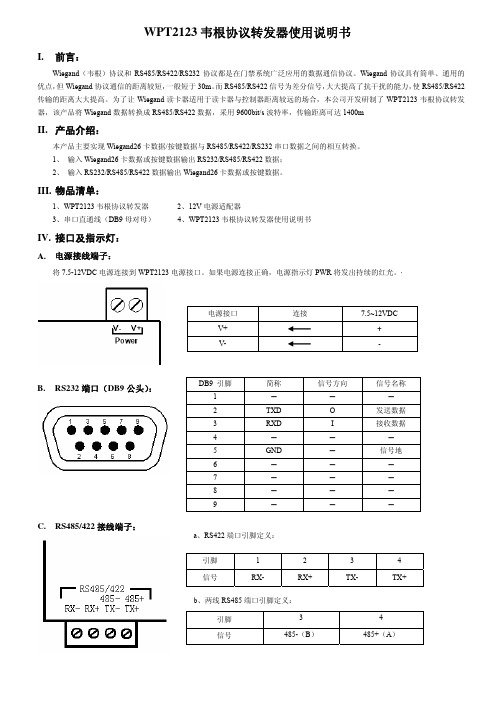
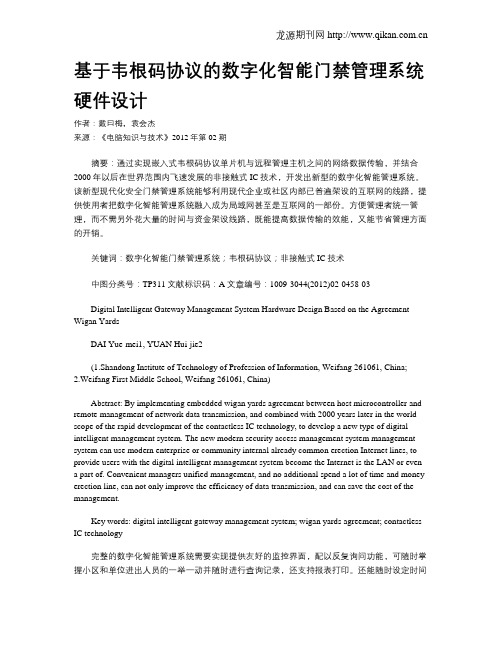
基于韦根码协议的数字化智能门禁管理系统硬件设计作者:戴曰梅,袁会杰来源:《电脑知识与技术》2012年第02期摘要:通过实现嵌入式韦根码协议单片机与远程管理主机之间的网络数据传输,并结合2000年以后在世界范围内飞速发展的非接触式IC技术,开发出新型的数字化智能管理系统。
该新型现代化安全门禁管理系统能够利用现代企业或社区内部已普遍架设的互联网的线路,提供使用者把数字化智能管理系统融入成为局域网甚至是互联网的一部份。
方便管理者统一管理,而不需另外花大量的时间与资金架设线路,既能提高数据传输的效能,又能节省管理方面的开销。
关键词:数字化智能门禁管理系统;韦根码协议;非接触式IC技术中图分类号:TP311文献标识码:A文章编号:1009-3044(2012)02-0458-03Digital Intelligent Gateway Management System Hardware Design Based on the Agreement Wigan YardsDAI Yue-mei1, YUAN Hui-jie2(1.Shandong Institute of Technology of Profession of Information, Weifang 261061, China;2.Weifang First Middle School, Weifang 261061, China)Abstract: By implementing embedded wigan yards agreement between host microcontroller and remote management of network data transmission, and combined with 2000 years later in the world scope of the rapid development of the contactless IC technology, to develop a new type of digital intelligent management system. The new modern security access management system management system can use modern enterprise or community internal already common erection Internet lines, to provide users with the digital intelligent management system become the Internet is the LAN or even a part of. Convenient managers unified management, and no additional spend a lot of time and money erection line, can not only improve the efficiency of data transmission, and can save the cost of the management.Key words: digital intelligent gateway management system; wigan yards agreement; contactless IC technology完整的数字化智能管理系统需要实现提供友好的监控界面,配以反复询问功能,可随时掌握小区和单位进出人员的一举一动并随时进行查询记录,还支持报表打印。
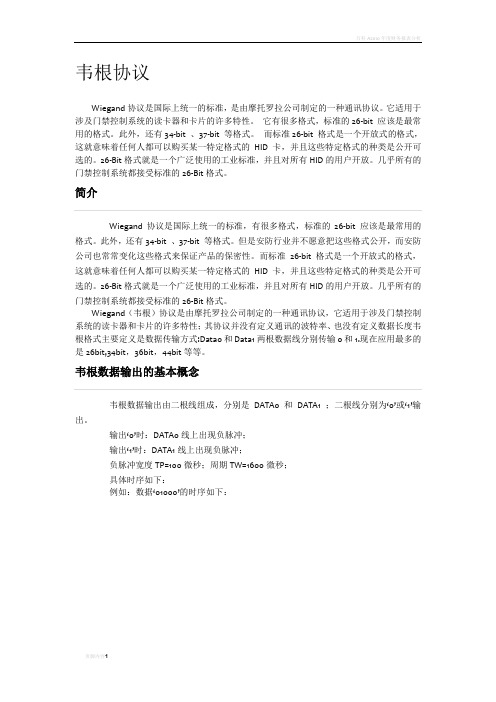
韦根协议Wiegand协议是国际上统一的标准,是由摩托罗拉公司制定的一种通讯协议。
它适用于涉及门禁控制系统的读卡器和卡片的许多特性。
它有很多格式,标准的26-bit 应该是最常用的格式。
此外,还有34-bit 、37-bit 等格式。
而标准26-bit 格式是一个开放式的格式,这就意味着任何人都可以购买某一特定格式的HID卡,并且这些特定格式的种类是公开可选的。
26-Bit格式就是一个广泛使用的工业标准,并且对所有HID的用户开放。
几乎所有的门禁控制系统都接受标准的26-Bit格式。
简介Wiegand协议是国际上统一的标准,有很多格式,标准的26-bit 应该是最常用的格式。
此外,还有34-bit 、37-bit 等格式。
但是安防行业并不愿意把这些格式公开,而安防公司也常常变化这些格式来保证产品的保密性。
而标准26-bit 格式是一个开放式的格式,这就意味着任何人都可以购买某一特定格式的HID卡,并且这些特定格式的种类是公开可选的。
26-Bit格式就是一个广泛使用的工业标准,并且对所有HID的用户开放。
几乎所有的门禁控制系统都接受标准的26-Bit格式。
Wiegand(韦根)协议是由摩托罗拉公司制定的一种通讯协议,它适用于涉及门禁控制系统的读卡器和卡片的许多特性;其协议并没有定义通讯的波特率、也没有定义数据长度韦根格式主要定义是数据传输方式:Data0和Data1两根数据线分别传输0和1.现在应用最多的是26bit,34bit,36bit,44bit等等。
韦根数据输出的基本概念韦根数据输出由二根线组成,分别是DATA0 和DATA1 ;二根线分别为‘0’或‘1’输出。
输出‘0’时:DATA0线上出现负脉冲;输出‘1’时:DATA1线上出现负脉冲;负脉冲宽度TP=100微秒;周期TW=1600微秒;具体时序如下:例如:数据‘01000’的时序如下:韦根26位输出格式标准韦根输出是由26位二进制数组成,每一位的含义如下:1 2 9 10 25 26X X X X X X X X X X X X X X X X X X X X X X X X X X 二进制第1位为2—13位的偶校验位第2—9位对应与电子卡HID码的低8位第10-25位对应电子卡的PID号码第26位为14-25位的奇校验位这26位数据在读出器的韦根输出线D0,D1上输出。
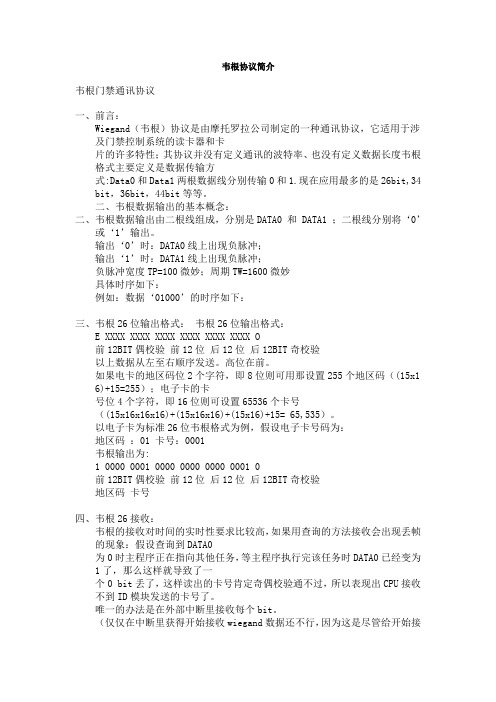
韦根协议简介韦根门禁通讯协议一、前言:Wiegand(韦根)协议是由摩托罗拉公司制定的一种通讯协议,它适用于涉及门禁控制系统的读卡器和卡片的许多特性;其协议并没有定义通讯的波特率、也没有定义数据长度韦根格式主要定义是数据传输方式:Data0和Data1两根数据线分别传输0和1.现在应用最多的是26bit,34 bit,36bit,44bit等等。
二、韦根数据输出的基本概念:二、韦根数据输出由二根线组成,分别是DATA0 和 DATA1 ;二根线分别将‘0’或‘1’输出。
输出‘0’时:DATA0线上出现负脉冲;输出‘1’时:DATA1线上出现负脉冲;负脉冲宽度TP=100微妙;周期TW=1600微妙具体时序如下:例如:数据‘01000’的时序如下:三、韦根26位输出格式:韦根26位输出格式:E XXXX XXXX XXXX XXXX XXXX XXXX O前12BIT偶校验前12位后12位后12BIT奇校验以上数据从左至右顺序发送。
高位在前。
如果电卡的地区码位2个字符,即8位则可用那设置255个地区码((15x16)+15=255);电子卡的卡号位4个字符,即16位则可设置65536个卡号((15x16x16x16)+(15x16x16)+(15x16)+15= 65,535)。
以电子卡为标准26位韦根格式为例,假设电子卡号码为:地区码:01 卡号:0001韦根输出为:1 0000 0001 0000 0000 0000 0001 0前12BIT偶校验前12位后12位后12BIT奇校验地区码卡号四、韦根26接收:韦根的接收对时间的实时性要求比较高,如果用查询的方法接收会出现丢帧的现象:假设查询到DATA0为0时主程序正在指向其他任务,等主程序执行完该任务时DATA0已经变为1了,那么这样就导致了一个0 bit丢了,这样读出的卡号肯定奇偶校验通不过,所以表现出CPU接收不到ID模块发送的卡号了。
唯一的办法是在外部中断里接收每个bit。
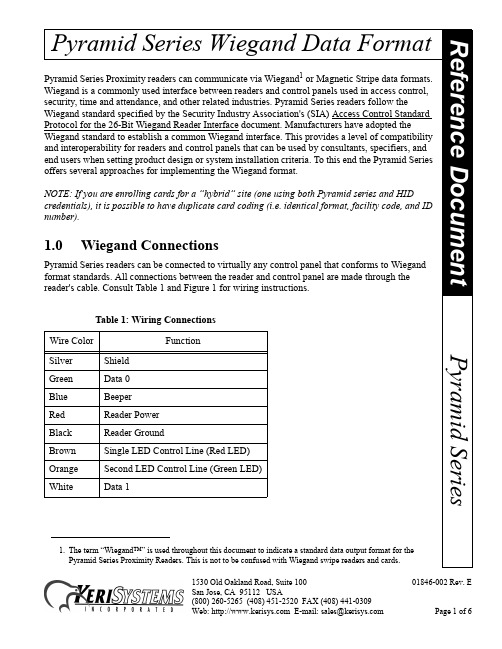
1530 Old Oakland Road, Suite 10001846-002 Rev. E Pyramid SeriesPyramid Series Proximity readers can communicate via Wiegand 1 or Magnetic Stripe data formats. Wiegand is a commonly used interface between readers and control panels used in access control, security, time and attendance, and other related industries. Pyramid Series readers follow the Wiegand standard specified by the Security Industry Association's (SIA) Access Control Standard Protocol for the 26-Bit Wiegand Reader Interface document. Manufacturers have adopted the Wiegand standard to establish a common Wiegand interface. This provides a level of compatibility and interoperability for readers and control panels that can be used by consultants, specifiers, and end users when setting product design or system installation criteria. To this end the Pyramid Series offers several approaches for implementing the Wiegand format.NOTE: If you are enrolling cards for a “hybrid” site (one using both Pyramid series and HID credentials), it is possible to have duplicate card coding (i.e. identical format, facility code, and ID number).1.0Wiegand ConnectionsPyramid Series readers can be connected to virtually any control panel that conforms to Wiegand format standards. All connections between the reader and control panel are made through the reader's cable. Consult Table 1 and Figure 1 for wiring instructions.1.The term “Wiegand™” is used throughout this document to indicate a standard data output format for the Pyramid Series Proximity Readers. This is not to be confused with Wiegand swipe readers and cards.Table 1: Wiring ConnectionsWire ColorFunction SilverShield GreenData 0BlueBeeper RedReader Power BlackReader Ground BrownSingle LED Control Line (Red LED)OrangeSecond LED Control Line (Green LED)White Data 11530 Old Oakland Road, Suite 10001846-002 Rev. EP y r a m i d S e r i e s Figure 1: Wiring Connections 2.0Data Signals Figure 2 displays the timing pattern for data bits sent by the reader to the access control panel. This timing pattern falls within the Wiegand guidelines as proscribed by the SIA's Access Control Standard Protocol for the 26-Bit Wiegand Reader Interface (a Pulse Width time between 20 uS and 100 uS, and a Pulse Interval time between 200 uS and 20 mS).The Data 1 and Data 0 signals are held at a logic high level (above the V oh level) until the reader is ready to send a data stream. The reader places data as asynchronous low-going pulses (below the V ol level) on the Data 1 or Data 0 lines to transmit the data stream to the access control panel (the "saw-teeth" in Figure 2). The Data 1 and Data 0 pulses will not overlap or occur simultaneously. Table 2 provides the minimum and maximum allowable pulse width times (the duration of a pulse) and pulse interval times (the time between pulses) for Pyramid Series Readers.Figure 2: Data Bit Timing Pattern1530 Old Oakland Road, Suite 10001846-002 Rev. E Pyramid Series3.0Wiegand FormatsPyramid Series readers feature pass-through technology. This means that any reader will read any and all formatting data programmed to any of the Pyramid Series credentials. Pyramid Series readers can be shipped from stock because unlike other proximity manufacturers, there is no format matching between readers and credentials.3.126-Bit Wiegand FormatThe composition of the open de facto industry standard 26 Bit Wiegand format contains 8 bits for the facility code field and 16 bits for the ID number field. Mathematically these 8 facility code bits allow for a total of just 256 (0 to 255) facility codes, while the 16 ID number bits allow for a total of only 65,536 (0 to 65,535) individual ID's within each facility code. Due to the mathematical limitations of the 26-bit Wiegand format, code duplication might occur. Table 3 provides a summary the 26-bit Wiegand format.Table 2: Pulse TimesSymbolDescription Pyramid Series Reader Typical Time TpwPulse Width Time 100 µs Tpi Pulse Interval Time 1 msTable 3: 26-bit Wiegand FormatBit NumberPurpose Bit 1Even parity over bits 2 to 13Bits 2 to 9Facility code (0 to 255); Bit 2 is MSB Bits 10 to 25ID Number (0 to 65,535); Bit 10 is MSB Bit 26Odd parity over bits 14 to 251530 Old Oakland Road, Suite 10001846-002 Rev. E P y r a m i d S e r i e s 3.2Pyramid Wiegand Format Several alternatives exist for customers who require more codes. The first is to switch to Keri's standard 39 bit Pyramid format. This 39 bit Wiegand format contains 17 bits for the facility code field and 20 bits for the ID number field. Mathematically these 17 facility code bits allow for a total of 131,072 (0 to 131,071) facility codes, while the 20 ID number bits allow for a total of 1,048,576 (0 to 1,048,575) individual ID's within each facility code. Since there are so many facility codes in the Pyramid format, a new facility code may be selected for each project. Additionally the large number of ID's per facility code makes the Pyramid format ideal for very large projects. For added security, Keri Systems tracks credential coding to ensure that no duplication occurs. Table 4 provides a summary of the Pyramid Wiegand format.3.3Custom Wiegand FormatsThe second alternative is to create a custom Wiegand format. Typically, up to 64 bits are available for creating a custom Wiegand format. With certain limitations, formats with greater than 64 bits may be created. If a customer currently has a custom Wiegand format from Wiegand or from other proximity manufacturers, Keri can normally match that format. Although the customer is primarily responsible for custom format card coding, as an added benefit Keri Systems tracks card coding for additional security. Table 5 provides an example of one possible custom Wiegand format.Table 4: Pyramid Wiegand FormatBit NumberPurpose Bit 1Even parity over bits 2 to 19Bits 2 to 18Facility code (0 to 131,071); Bit 2 is MSB Bits 19 to 38ID Number (0 to 1,048,575); Bit 19 is MSB Bit 39Odd parity over bits 20 to 38Table 5: Example of a Custom Wiegand Format Bit Number Purpose Bit 1Even parity over bits 2 to 22Bits 2 to 9OEM code (0 to 255); Bit 2 is MSB Bits 10 to 21Facility code (0 to 4,096); Bit 10 is MSB Bits 22 to 43ID Number (0 to 524,287); Bit 22 is MSB Bit 44Odd parity over bits 23 to 431530 Old Oakland Road, Suite 10001846-002 Rev. E Pyramid Series3.4The 8-bit Burst Format of the P-600 Rocky Proximity Reader and Key-pad The P-600 reader is capable of transmitting data in the 26-bit Wiegand format described above, but its default data transmission configuration is Wiegand 8-bit burst. The timing pattern for data bits generated in the 8-bit burst format follows the pattern described in the Data Signals section beginning on page 2. In 8-bit burst mode, each keystroke prompts the reader to transmit 8 bits of data according to Table 6.For further details on the Pyramid Series product line or on creating custom Wiegand formats, please contact Keri Systems.Table 6: Wiegand 8-bit Burst DataFormatKeypadEntryBinary Data Decimal Equivalent 011110000240111100001225211010010210311000011195410110100180510100101165610010110150710000111135801111000120901101001105*010*******#010*******1530 Old Oakland Road, Suite 10001846-002 Rev. EPy r a m i d S e r i e s This page is intentionally left blank.。
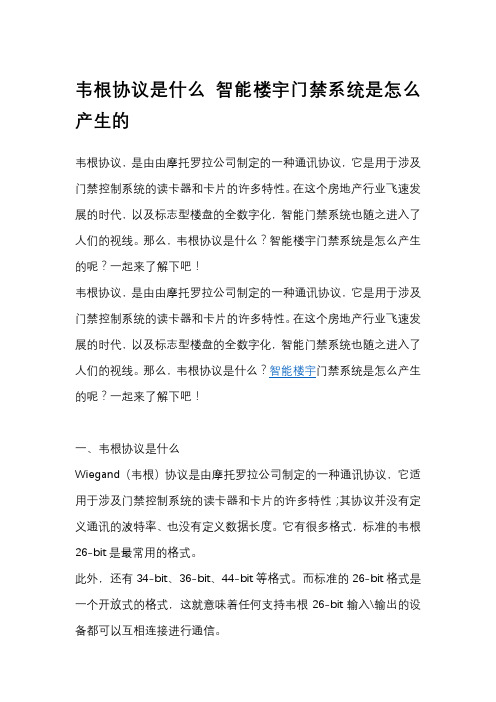
韦根协议是什么智能楼宇门禁系统是怎么产生的韦根协议,是由由摩托罗拉公司制定的一种通讯协议,它是用于涉及门禁控制系统的读卡器和卡片的许多特性。
在这个房地产行业飞速发展的时代,以及标志型楼盘的全数字化,智能门禁系统也随之进入了人们的视线。
那么,韦根协议是什么?智能楼宇门禁系统是怎么产生的呢?一起来了解下吧!韦根协议,是由由摩托罗拉公司制定的一种通讯协议,它是用于涉及门禁控制系统的读卡器和卡片的许多特性。
在这个房地产行业飞速发展的时代,以及标志型楼盘的全数字化,智能门禁系统也随之进入了人们的视线。
那么,韦根协议是什么?智能楼宇门禁系统是怎么产生的呢?一起来了解下吧!一、韦根协议是什么Wiegand(韦根)协议是由摩托罗拉公司制定的一种通讯协议,它适用于涉及门禁控制系统的读卡器和卡片的许多特性;其协议并没有定义通讯的波特率、也没有定义数据长度。
它有很多格式,标准的韦根26-bit是最常用的格式。
此外,还有34-bit、36-bit、44-bit等格式。
而标准的26-bit格式是一个开放式的格式,这就意味着任何支持韦根26-bit输入\输出的设备都可以互相连接进行通信。
1、韦根协议的传输Wiegand接口通常由3根线组成,它们是:DATA0,DATA1和GND。
韦根码在数据的传输中只需两条数据线,一条为DATA0,另一条为DATA1。
协议规定,两条数据线在无数据时均为高电平,如果DATA0为低电平代表数据0,DATA1为低电平代表数据1(低电平信号低于1V,高电平信号大于4V)。
数据信号波形如下图所示。
2、韦根协议存在的隐患韦根协议是一种单工通信协议,在门禁系统中,韦根数据只能由读卡器至控制器单向传输。
当读卡器识读到有效卡后,将卡片的钥匙信息以韦根协议的方式传输至控制器,控制器验证钥匙信息有效后打开门。
在这一过程中,控制器并未对读卡器的合法性进行验证,即未确定韦根数据的来源是不是系统内合法的读卡器。
如果韦根数据在传输的过程中被非法人员窃取,并模拟读卡器再次发送此韦根数据给控制器,就会对控制器形成欺骗,导致后者认为收到了有效卡的钥匙信息而打开门。
gpio 读取韦根协议读取韦根协议的方法通常需要通过硬件连接来实现。
首先,将读卡器(如韦根协议脉冲输出接口)的信号引脚连接到树莓派的GPIO引脚上。
然后,使用树莓派的编程语言(如Python)来读取GPIO引脚的状态,以获取韦根协议的数据。
具体步骤如下:1. 在树莓派上安装相应的编程语言(如Python)及相关的GPIO库(如RPi.GPIO),用于控制GPIO引脚。
2. 了解韦根协议的传输方式和协议规范。
韦根协议通常使用脉冲宽度来表示不同的数据,根据协议规范解码数据。
3. 根据韦根协议的规范,使用GPIO库中的函数来监听所连接的GPIO引脚的状态变化。
例如,在Python中,可以使用RPi.GPIO库的`add_event_detect`方法来监测GPIO的状态变化。
4. 在状态变化的回调函数中,根据韦根协议的规范,解码读取到的数据。
下面是一个简单的Python示例代码,用于读取GPIO引脚上的韦根协议数据:```pythonimport RPi.GPIO as GPIO# 设置GPIO引脚模式为BCM编码方式GPIO.setmode(GPIO.BCM)# 设置GPIO引脚input_pin = 18GPIO.setup(input_pin, GPIO.IN, pull_up_down=GPIO.PUD_UP)def handle_input(channel):# 这里是读取韦根协议的逻辑,根据具体协议规范进行解码并处理数据data = # 根据协议规范解码数据print('Received data:', data)# 监听GPIO引脚状态变化GPIO.add_event_detect(input_pin, GPIO.FALLING,callback=handle_input, bouncetime=200)# 等待中断事件try:while True:passexcept KeyboardInterrupt:pass# 清除GPIO设置GPIO.cleanup()```请注意,以上代码中的输入引脚(`input_pin`)需要根据具体的硬件连接进行配置。
用户手册版权所有©杭州海康威视数字技术股份有限公司2018。
保留一切权利。
本手册的任何部分,包括文字、图片、图形等均归属于杭州海康威视数字技术股份有限公司或其子公司(以下简称“本公司”或“海康威视”)。
未经书面许可,任何单位和个人不得以任何方式摘录、复制、翻译、修改本手册的全部或部分。
除非另有约定,本公司不对本手册提供任何明示或默示的声明或保证。
关于本手册本手册描述的产品仅供中国大陆地区销售和使用。
本手册作为指导使用。
手册中所提供照片、图形、图表和插图等,仅用于解释和说明目的,与具体产品可能存在差异,请以实物为准。
因产品版本升级或其他需要,本公司可能对本手册进行更新,如您需要最新版手册,请您登录公司官网查阅()。
海康威视建议您在专业人员的指导下使用本手册。
商标声明为海康威视的注册商标。
本手册涉及的其他商标由其所有人各自拥有。
责任声明在法律允许的最大范围内,本手册所描述的产品(含其硬件、软件、固件等)均“按照现状”提供,可能存在瑕疵、错误或故障,本公司不提供任何形式的明示或默示保证,包括但不限于适销性、质量满意度、适合特定目的、不侵犯第三方权利等保证;亦不对使用本手册或使用本公司产品导致的任何特殊、附带、偶然或间接的损害进行赔偿,包括但不限于商业利润损失、数据或文档丢失产生的损失。
若您将产品接入互联网需自担风险,包括但不限于产品可能遭受网络攻击、黑客攻击、病毒感染等,本公司不对因此造成的产品工作异常、信息泄露等问题承担责任,但本公司将及时为您提供产品相关技术支持。
使用本产品时,请您严格遵循适用的法律。
若本产品被用于侵犯第三方权利或其他不当用途,本公司概不承担任何责任。
如本手册内容与适用的法律相冲突,则以法律规定为准。
前言本节内容的目的是确保用户通过本手册能够正确使用产品,以避免操作中的危险或财产损失。
在使用此产品之前,请认真阅读产品手册并妥善保存以备日后参考。
符号约定在本文中可能出现下列标志,它们所代表的含义如下。
标准韦根26通讯格式1、前言:Wiegand(韦根)协议是由摩托罗拉公司制定的一种通讯协议,它适用于涉及门禁控制系统的读卡器和卡片的许多特性;其协议并没有定义通讯的波特率、也没有定义数据长度韦根格式主要定义是数据传输方式:Data0和Data1两根数据线分别传输0和1。
现在应用最多的是26bit,34bit,36bit,44bit等等。
2、维根数据输出的基本概念:维根数据输出由二根线组成,分别是DATA0和DATA1;二根线分别将0或1输出。
输出0时:DATA0线上出现负脉冲;输出1时:DATA1线上出现负脉冲;负脉冲宽度TP=100微妙;周期TW=1600微妙3、维根26位输出格式:标准韦根输出是由26位二进制数组成,每一位的含义如下:1 2 9 10 13 25 26E X X X X X X X X X X X X X X X X X X X X X X X X O 二进制第1位为2-13位的偶校验位第2-9位对应与电子卡HID码的低8位第10-25位对应电子卡的PID号码第26位为14-25位的奇校验位以上数据从左至右顺序发送。
高位在前。
例如:一只HID:16385,PID:00004的电子卡其26位韦根输出为:1 0 0 0 0 0 0 0 1 0 0 0 0 0 0 0 0 0 0 0 0 0 1 0 0 0检验位HID =16385(二进制的低8位)PID = 4(二进制)检验位这26位数据在读出器的韦根输出线DATA0,DATA1上输出。
DATA0,DATA1在没有数据输出时都保持+5V高电平。
若输出为0,则DATA0拉低一段时间,若输出为1,则DATA1拉低一段时间。
两个电子卡韦根输出之间的最小间隔为0.25秒。
4、维根26接收:韦根的接收对时间的实时性要求比较高,如果用查询的方法接收会出现丢帧的现象:假设查询到DATA0为0时主程序正在指向其他任务,等主程序执行完该任务时DATA0已经变为1了,那么这样就导致了一个0?bit丢了,这样读出的卡号肯定奇偶校验通不过,所以表现出CPU接收不到ID模块发送的卡号了。
韦根协议Wiega nd协议是国际上统一的标准,是由摩托罗拉公司制定的一种通讯协议。
它适用于涉及门禁控制系统的读卡器和卡片的许多特性。
它有很多格式,标准的26-bit应该是最常用的格式。
此外,还有34-bit、37-bit等格式。
而标准26-bit格式是一个开放式的格式,这就意味着任何人都可以购买某一特定格式的HID卡,并且这些特定格式的种类是公开可选的。
26-Bit格式就是一个广泛使用的工业标准,并且对所有HID的用户开放。
几乎所有的门禁控制系统都接受标准的26-Bit格式。
简介Wiegand协议是国际上统一的标准,有很多格式,标准的26-bit应该是最常用的格式。
此外,还有34-bit、37-bit等格式。
但是安防行业并不愿意把这些格式公开,而安防公司也常常变化这些格式来保证产品的保密性。
而标准26-bit格式是一个开放式的格式,这就意味着任何人都可以购买某一特定格式的HID卡,并且这些特定格式的种类是公开可选的。
26-Bit格式就是一个广泛使用的工业标准,并且对所有HID的用户开放。
几乎所有的门禁控制系统都接受标准的26-Bit格式。
Wiegand (韦根)协议是由摩托罗拉公司制定的一种通讯协议,它适用于涉及门禁控制系统的读卡器和卡片的许多特性;其协议并没有定义通讯的波特率、也没有定义数据长度韦根格式主要定义是数据传输方式:DataO和Datal两根数据线分别传输0和1.现在应用最多的是26bit,34bit,36bit,44bit 等等。
韦根数据输出的基本概念ov■45Vov二进制号码o1韦根26位输出格式标准韦根输出是由 26位二进制数 组成,每一位的含义如下:1 2 9 10 25 26X X X X X X X X X X X X X X X X X X X X X X X X X X 二进制第1位为2 —13位的偶校验位 第29位对应与电子卡HID 码的低8位第10-25位对应电子卡的 PID 号码这26位数据在读出器的韦根输出线 DO , D1上输出。
矿产资源开发利用方案编写内容要求及审查大纲
矿产资源开发利用方案编写内容要求及《矿产资源开发利用方案》审查大纲一、概述
㈠矿区位置、隶属关系和企业性质。
如为改扩建矿山, 应说明矿山现状、
特点及存在的主要问题。
㈡编制依据
(1简述项目前期工作进展情况及与有关方面对项目的意向性协议情况。
(2 列出开发利用方案编制所依据的主要基础性资料的名称。
如经储量管理部门认定的矿区地质勘探报告、选矿试验报告、加工利用试验报告、工程地质初评资料、矿区水文资料和供水资料等。
对改、扩建矿山应有生产实际资料, 如矿山总平面现状图、矿床开拓系统图、采场现状图和主要采选设备清单等。
二、矿产品需求现状和预测
㈠该矿产在国内需求情况和市场供应情况
1、矿产品现状及加工利用趋向。
2、国内近、远期的需求量及主要销向预测。
㈡产品价格分析
1、国内矿产品价格现状。
2、矿产品价格稳定性及变化趋势。
三、矿产资源概况
㈠矿区总体概况
1、矿区总体规划情况。
2、矿区矿产资源概况。
3、该设计与矿区总体开发的关系。
㈡该设计项目的资源概况
1、矿床地质及构造特征。
2、矿床开采技术条件及水文地质条件。